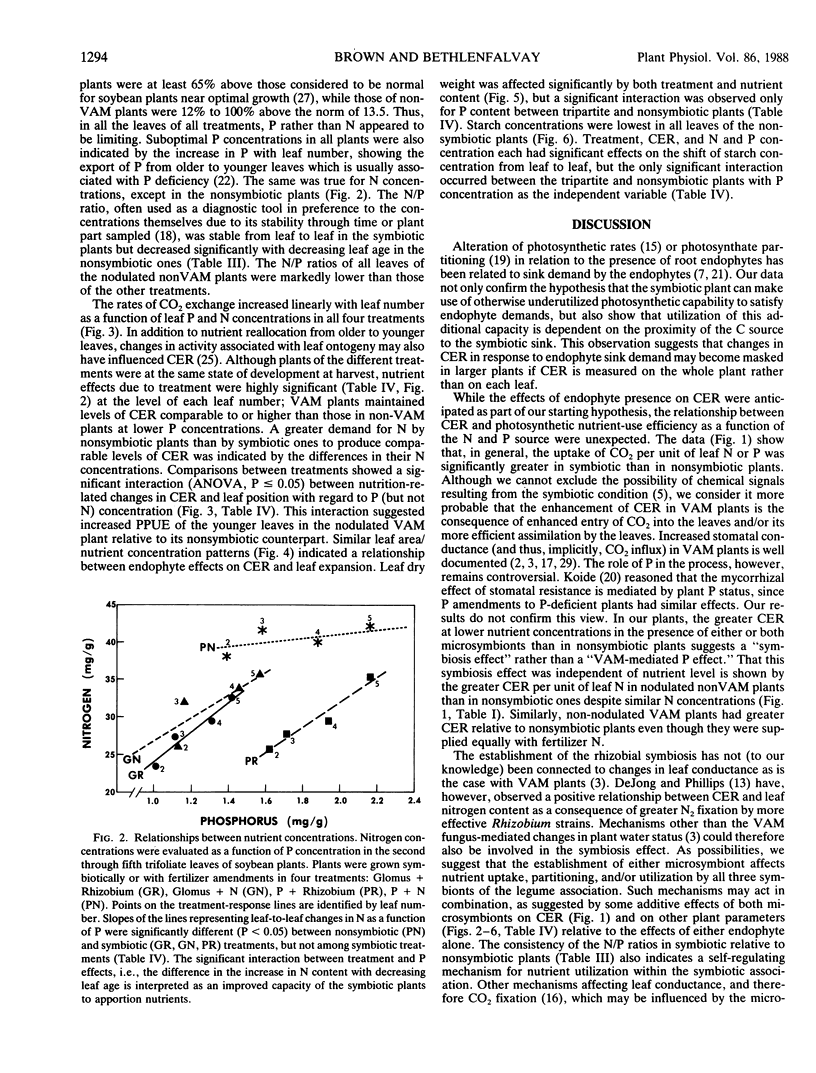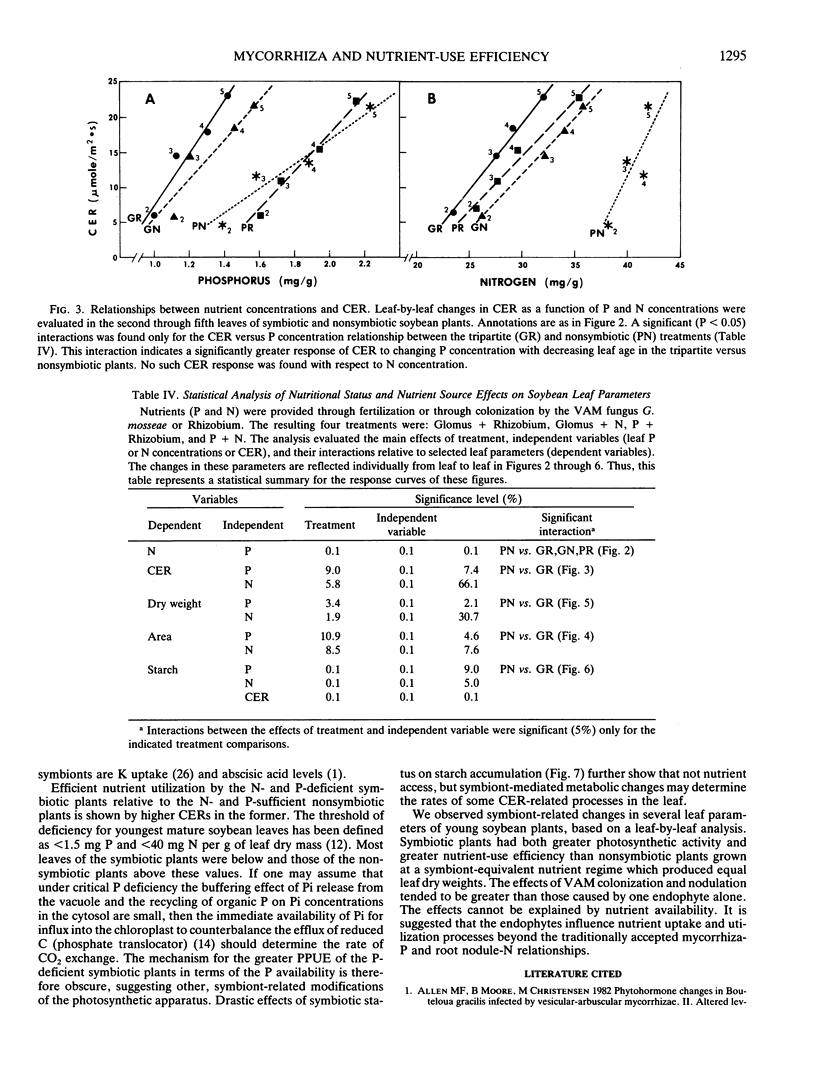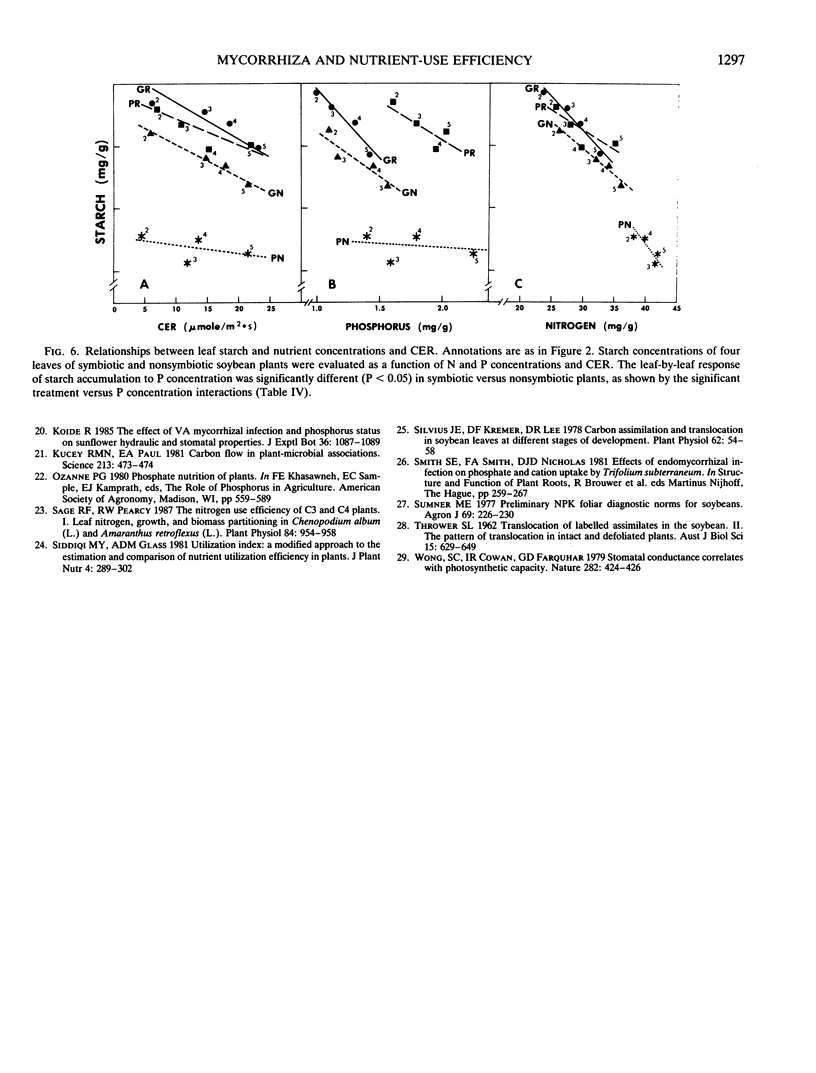Abstract
Four consecutive trifoliate leaves of 56-day-old symbiotic or nonsymbiotic soybean plants were evaluated individually for CO2 exchange rates (CER), leaf area and dry weight, and leaf N, P, and starch concentrations. Plants had been inoculated with the vesicular-arbuscular mycorrhizal (VAM) fungus Glomus mosseae and Rhizobium japonicum, with either of the endophytes alone, or with neither at time of planting. Plants lacking one or both endophytes received N and/or P fertilizers to produce plants of equal total leaf dry weight in all four treatments. Photosynthetic P-use efficiency (CER per unit leaf P) was higher in the leaves of VAM plants than in P-fertilized plants regardless of the N source (N2 fixation or combined N). Photosynthetic N-use efficiency was also higher in VAM than in non-VAM plants, but it was affected by the N source, with higher CER in the nodulated plants. The greatest differences in CER, starch accumulation and leaf area were found between the nonsymbiotic plants and those with both endophytes. Statistical evaluations of leaf parameters for treatment or nutrient concentration (N and P) effects between the tri-partite and the nonsymbiotic treatments showed significant changes in concentration of P, but not N, with decreasing leaf age. Both endophytes apparently enhance CO2 fixation at N and/or P concentrations lower than those of the nonsymbiotic plants. The effects of the endophytes on CO2 fixation were additive.
Full text
PDF





Selected References
These references are in PubMed. This may not be the complete list of references from this article.
- Bethlenfalvay G. J., Brown M. S., Stafford A. E. Glycine-Glomus-Rhizobium Symbiosis: II. Antagonistic Effects between Mycorrhizal Colonization and Nodulation. Plant Physiol. 1985 Dec;79(4):1054–1058. doi: 10.1104/pp.79.4.1054. [DOI] [PMC free article] [PubMed] [Google Scholar]
- Brown M. S., Bethlenfalvay G. J. Glycine-Glomus-Rhizobium Symbiosis : VI. Photosynthesis in Nodulated, Mycorrhizal, or N- and P-Fertilized Soybean Plants. Plant Physiol. 1987 Sep;85(1):120–123. doi: 10.1104/pp.85.1.120. [DOI] [PMC free article] [PubMed] [Google Scholar]
- Dejong T. M., Phillips D. A. Nitrogen Stress and Apparent Photosynthesis in Symbiotically Grown Pisum sativum L. Plant Physiol. 1981 Aug;68(2):309–313. doi: 10.1104/pp.68.2.309. [DOI] [PMC free article] [PubMed] [Google Scholar]
- Koch K. E., Johnson C. R. Photosynthate partitioning in split-root citrus seedlings with mycorrhizal and nonmycorrhizal root systems. Plant Physiol. 1984 May;75(1):26–30. doi: 10.1104/pp.75.1.26. [DOI] [PMC free article] [PubMed] [Google Scholar]
- Paul E. A., Kucey R. M. Carbon flow in plant microbial associations. Science. 1981 Jul 24;213(4506):473–474. doi: 10.1126/science.213.4506.473. [DOI] [PubMed] [Google Scholar]
- Sage R. F., Pearcy R. W. The Nitrogen Use Efficiency of C(3) and C(4) Plants: I. Leaf Nitrogen, Growth, and Biomass Partitioning in Chenopodium album (L.) and Amaranthus retroflexus (L.). Plant Physiol. 1987 Jul;84(3):954–958. doi: 10.1104/pp.84.3.954. [DOI] [PMC free article] [PubMed] [Google Scholar]
- Silvius J. E., Kremer D. F., Lee D. R. Carbon assimilation and translocation in soybean leaves at different stages of development. Plant Physiol. 1978 Jul;62(1):54–58. doi: 10.1104/pp.62.1.54. [DOI] [PMC free article] [PubMed] [Google Scholar]
- Twardzik D. R., Todaro G. J., Marquardt H., Reynolds F. H., Jr, Stephenson J. R. Transformation induced by Abelson murine leukemia virus involves production of a polypeptide growth factor. Science. 1982 May 21;216(4548):894–897. doi: 10.1126/science.6177040. [DOI] [PubMed] [Google Scholar]


